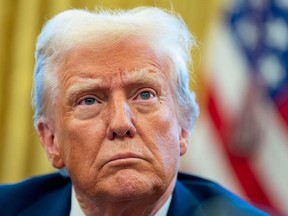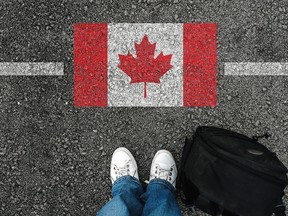Everything you need to know about the U.S. President’s latest economic curve ball
Article content
U.S. president Donald Trump signed a memorandum Thursday calling for reciprocal trade tariffs on all major trading partners.
Article content
Article content
“I have decided for purposes of fairness that I will charge a reciprocal tariff. Meaning whatever countries charge the United States of America we will charge them, no more no less,” Trump said as he signed the executive order.
“In almost all cases, they are charging us vastly more than what we charge them, but those days are over,” he said.
Advertisement 2
Article content
But what are reciprocal tariffs exactly? Which countries are they likely to target, and will Canada be among them? Here’s what you need to know about Trump’s latest economic curve ball.
What are reciprocal tariffs?
Fen Osler Hampson, professor of international affairs at Carleton University and co-chair of the Expert Group on Canada-U.S. Relations, compared reciprocal tariffs to biblical justice: “An eye for an eye, a tooth for a tooth.”
For example, if Europe had a 10 per cent tariff on American imports and the U.S. had a three per cent tariff on European imports, the U.S. would raise their tariffs to match Europe’s.
“If the Europeans decide to escalate, then (the U.S. will) escalate. If (Americans) decide to reduce, (Europeans) will reduce,” Hampson explained. “So, it’s pretty simple, it’s tit for tat.”
How could the U.S. implement them?
It’s unclear what approach Trump might take to impose reciprocal tariffs.
“We need to see details on rates, which countries and sectors, and timing. We may or may not get all of that today,” wrote Derek Holt, vice president and head of capital markets economics at Scotiabank in a note. “Trump’s pattern is to make a splash, and then hold off.”
Article content
Advertisement 3
Article content
Trump could potentially match the same average tariffs that American trading partners charge on U.S. imports. Or he could reciprocate on a good-by-good basis, matching levies charged on specific products and items.
Hampson said Trump could first order an investigation to decide how best to implement reciprocal tariffs, or he could sign a directive to put them in place straightaway with a set timeline.
“The other $64,000 question is, what does this mean for his earlier campaign commitment for across-the-board tariffs?” Hampson asked, explaining that reciprocal tariffs could compound existing or promised levies.
Deutsche Bank economists, led by Justin Weidner, estimated in a Monday note that the U.S.’ weighted average tariff rate could hit 4.8 per cent with reciprocal tariffs — a 3.3 per cent jump from the 1.5 per cent rate U.S. imports had in 2022, according to the World Bank.
Who is likely to be most affected?
Hampson said countries that have protectionist measures in place for their agriculture could be impacted the most. Typically, developing countries tend to impose higher tariffs in order to increase revenue and protect their domestic industries until they have the capacity to compete with more industrialized countries.
Advertisement 4
Article content
Hampson added there’s “no question” that India would take a big hit from reciprocal tariffs. In 2022, America’s average tariff rate on imports from India was three per cent, in comparison to India’s average tariff rate on American imports at 9.5 per cent.
White House economic adviser Kevin Hassett told CNBC this week that India’s tariffs on American imports were “enormously high” and that Modi “has got a lot to talk about.”
Still, Hampson noted reciprocal tariffs on India could have major repercussions if the U.S. is looking to make India a strategic trading partner against China. It’s possible that Trump’s meeting with Modi could lead to a trade agreement instead.
However, the bottom line is that American consumers will bear the brunt of tariffs, Hampson warned. “(Trump) keeps using the tariff cudgel to try to beat America’s trading partners into submission,” he said, “But it’s a cudgel that is blunted by the effect of inflation.”
U.S. inflation is already up three per cent compared to last year’s numbers and economists are forecasting that tariffs could push prices up even further. “If the delayed Canada and Mexico tariffs were to ultimately go into effect as well, inflation in 2025 could be above 3.5 per cent,” Deutsche Bank economists said in their recent note.
Advertisement 5
Article content
Peterson Institute researchers have predicted that Trump’s threat of 25 per cent tariffs on most goods from Canada and Mexico (Canadian energy faces a 10 per cent tariff instead) and a 10 per cent increase in levies on Chinese imports could equate to a tax increase of more than $1,200 a year for the median American household.
Would the new tariffs affect Canada?
Hampson believes Canada will not be impacted by reciprocal tariffs because of the free trade agreement, and went so far as to suggest that America’s raised levies against other countries could be to Canada’s advantage.
“The Americans are going to want to cut deals because it’s going to raise the price of everything very quickly,” he said. “Everyone’s going to feel a lot of pain here, but American consumers are going to feel it heavily, because the United States imports a lot (of goods).”
Recommended from Editorial
-

U.S. futures waver as Trump signals new tariffs coming
-

How will Trump’s tariffs on steel and aluminum impact Canada?
With files from Jane Switzer
• Email: slouis@postmedia.com
Bookmark our website and support our journalism: Don’t miss the business news you need to know — add financialpost.com to your bookmarks and sign up for our newsletters here.
Article content
What Donald Trump’s reciprocal tariffs could mean for Canada
2025-02-13 18:15:32







